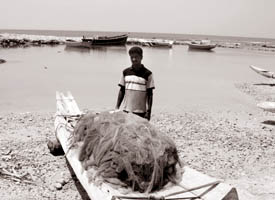|
DAILY NEWS ONLINE |
|
|
|
OTHER EDITIONS |
|
|
|
|
|
|
|
|
|
OTHER LINKS |
|
|
|
|
|
|
  |
Sights and sounds of Jaffna
Jaffna peninsula which points towards the west to the tip of India is a flat dry land with shallow lagoons and a number of offshore islands. The narrow neck of the peninsula, occupied by the Chundikkulam bird sanctuary and causeway known as Elephant Pass, connects it to the rest of Sri Lanka. Kayts, Karaitivu and Punkudutivu islands are joined to the mainland by causeways over the shallow water around the peninsula. Delft, Eluvaitivu, Analaitivu, Nainativu, Mandaitivu and Kurikaddawan islands are accessible only by ferry. Most areas in the Jaffna peninsula are dry and sandy. The most common tree is the palmyra palm with its elegant fan like fronds. The people of Jaffna peninsula have their own unique character. They are a kindred society unified by a common history. The ties and obligations felt by individuals to their community reflect the tradition of strong family ties. Intelligent as well as hard working, the people of Jaffna are tolerant and respectful of each other. The people of Jaffna have been able to blend tradition and modernity. After the rule of Chola empire in the Jaffna peninsula the Arya Chakravathi dynasty reigned from 1240 to 1450. Jaffna was occupied by the Portuguese (1617 to 1658) and the Dutch (1658 to 1795) until the British conquest. The British period of colonial rule shaped the future of Jaffna city in significant ways. Jaffna peninsula has many places of interest. The Jaffna Fort, which was build by the Dutch in 1680 is probably the best architecturally designed Dutch fort in all Asia. The centrally positioned star shaped 22 hectare fort was covered by a grass mound and surrounded by a moat. Nallur Kandaswamy Kovil, north of the town centre is Jaffna's best known and most significant Hindu kovil. The original Murugan temple was built in the 15th century. The beautifully maintained large open aired complex has shrines that represent Hindu deities. Nagadipa temple is built on one of the sites where the Buddha visited. This large open aired complex of Naga Pooshani Amman Kovil is situated on the Nainativu island near Jaffna peninsula. Nagadipa a favourite pilgrim location, visited by Sri Lankans irrespective of their religions is an important destination to foster reconciliation and peace. The newly reopened Jaffna public library considered as one of the finest libraries in South Asia is an important place symbolically. Delft island which is named after the Dutch ceramics town is 10 km from Punkudutivu. The island bears traces of Portuguese and Dutch eras. The 2000 year old Katarodai ruins, with its twenty dagobas lies west of Chunnakam in the Jaffna peninsula. The largest Roman Catholic cathedral in Jaffna is St. Mary's. St. John, the Baptist church is the first Anglican church in Sri Lanka, dates from early 19th century. Jaffna has countless Hindu temples ranging from sprawling complexes with towering gopurams and mandapams. Kopai cemetery, Nelliady shrine, Dhurakai Amman kovil are some of the heritage sites in the Jaffna peninsula. Point Pedro and Kankesanturai are all year around beach destinations with brilliant sunshine, dry weather and perfect sea conditions. EconomyIn the Jaffna peninsula all field crops are raised largely by natural rainfall. Water from the underground water tables lies near the surface. Some islands near the Jaffna peninsula have ponds or small lakes. True to their endeavour to protect unspoiled ecological wonders, Jaffna people use mainly organic fertiliser and crop rotation cultivation. Planting for the most part occurs during the north eastern monsoon season. Paddy, coconut, potatoes, chillies and onions are the main agro based industries in the area nearly. 18,875 acres of paddy and 1960 acres of coconut are grown in the Jaffna peninsula. Jaffna peninsula is renowned for its agriculture. It is aided by irrigation from limestone wells and farmers who are now returning to commercial volumes of production. The peninsula is also famous for its distinctively tasty mangoes. Jaffna peninsula is also the leading area in the Northern Province for the production of milk. Daily 13,818 litres of milk are produced. Fishing is the traditional livelihood of the people of the Jaffna peninsula. The fisheries industry plays a major role in the peninsula and has an annual catch of 5,310 tonnes. Gurunagar is the major fishing port in the peninsula. An excellent business framework has been outlined by the Jaffna Chamber of Commerce, Jaffna Chamber of Commerce and Industries of Yalpanam and the Jaffna Chamber of Small and Micro Industries and gives new impetus and dimension to the Jaffna peninsula investment climate. The history of Jaffna challenges the imagination and enchants the visitor who seeks natural beauty and tranquility. (The writer is a consultant of International Alert, who visited Jaffna Peninsula from September 14-18). |
|
|
 Jaffna peninsula maintains a sense of identity with a divinely
determined past moving towards a bright future. Jaffna situated 450 km
North of Colombo has been a strategic location in the Northern region of
Sri Lanka. The Jaffna peninsula consist of 2,587 square kilometre land
area and is almost an island with a special ambience not felt anywhere
else in the country.
Jaffna peninsula maintains a sense of identity with a divinely
determined past moving towards a bright future. Jaffna situated 450 km
North of Colombo has been a strategic location in the Northern region of
Sri Lanka. The Jaffna peninsula consist of 2,587 square kilometre land
area and is almost an island with a special ambience not felt anywhere
else in the country. 